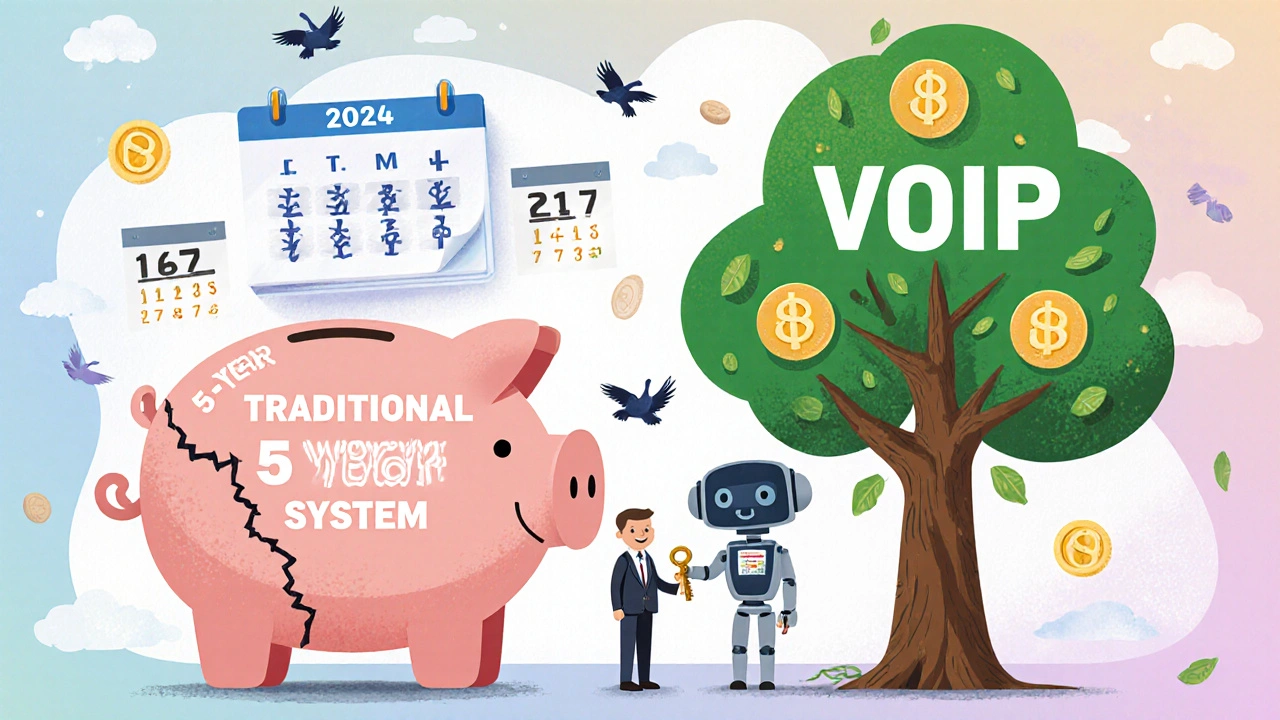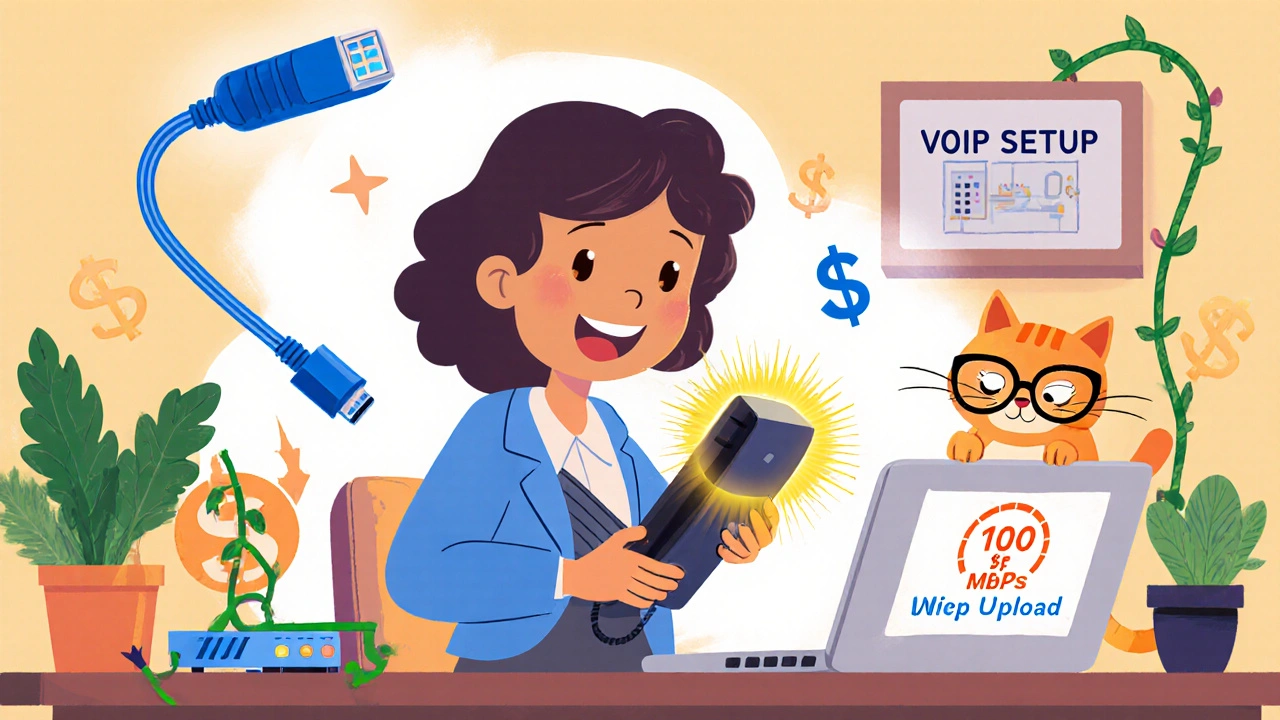Switching to VoIP sounds like a smart move-lower monthly bills, better features, no more copper wires. But before you cancel your old phone service, you need to know what it actually costs to get started. A lot of businesses think VoIP is free because they see $10/month plans online. That’s not the whole story. The real question isn’t how much you’ll pay each month-it’s how much you need to spend upfront to make it work.
What You Actually Pay Upfront
The biggest surprise for most businesses? VoIP setup isn’t about buying a fancy PBX box anymore. Most companies today use cloud-based VoIP, which means the phone system lives on the internet, not in your office. That cuts out the biggest expense of traditional phone systems: the on-site server. But you still need to spend money before you make your first call. Let’s break it down. The first line item is hardware. You need phones. Not the old desk phones with cords-these are IP phones that plug into your network. Basic models start around $50, but most businesses go with something in the $150-$200 range. Why? Because cheap phones often have poor audio, weak microphones, and no video calling. If you’re running a call center or do a lot of client meetings, you’ll notice the difference fast. For a 10-person team, that’s $1,500-$2,000 just for phones. A 20-person team? Around $3,000. You can lease them instead-$5 to $20 per phone per month-which spreads the cost out. But if you lease, you’re locked in for 2-3 years. No easy exit.Network Upgrades: The Hidden Cost
Here’s where most people get burned. VoIP runs on your internet connection. But not all networks are built for voice. If your office still has old CAT5 cabling, you’ll need to upgrade to CAT5e or CAT6. Why? Because VoIP needs stable, fast, and prioritized data. Without it, calls drop, echo, or cut out. You also need Quality of Service (QoS) settings on your router. This tells your network: "Voice traffic comes first." If your router is older than 2020, it probably doesn’t support QoS well-or at all. Replacing it costs $200-$500. And if your internet speed is below 100 Mbps upload, you might need to upgrade your plan. Business-grade internet can add $200-$500 per month to your bill. One user on Reddit spent $8,000 on new switches and cabling after thinking they’d save $10,000 by switching to VoIP. That’s not rare. If your network is outdated, the upfront cost can easily hit $5,000-$10,000 before you even turn on a phone.Setup, Porting, and Training
Then there’s the setup. Moving your existing phone numbers to VoIP? That’s $25 per number. Doesn’t sound like much-until you have 20 lines. That’s $500 right there. Professional setup services run $50-$150 per hour. For a small business, you’re looking at 10-20 hours of work: configuring users, setting up voicemail, linking to your CRM, testing call routing. That’s $1,000-$3,000 in labor. Some providers include this in the price, especially if you sign a 2-3 year contract. Others charge extra. Always ask. Training is another hidden cost. Employees don’t just pick up a phone and know how to forward calls or use video conferencing. Basic training is often free. Advanced features-like call recording, auto-attendants, or mobile app integration-might cost $500+ for a half-day session. Skip this, and your team will keep calling IT for help.
VoIP vs Traditional Phone: The Real Math
Let’s compare apples to apples. A traditional phone system for a 10-person office? You’re looking at $5,000-$10,000 for hardware, installation, and wiring. Plus, you need an IT person to maintain it. Monthly costs? $40-$80 per user. VoIP? Initial setup: $2,000-$7,000 (depending on network needs). Monthly cost: $10-$40 per user. Over five years, the traditional system could cost you $25,000-$40,000. VoIP? Around $8,000-$15,000. That’s a 50-75% savings. But here’s the catch: those savings only happen if you don’t ignore the hidden costs. If you skip the network upgrade, you’ll spend more on dropped calls and frustrated employees. If you buy cheap phones, you’ll replace them in two years. If you don’t train your team, productivity drops.How to Minimize Your Initial Investment
You don’t need to spend $10,000 to start. Here’s how to keep it low:- Use softphones. If your team has smartphones or laptops, install a VoIP app. No hardware needed. You can start with 5 users for under $500.
- Lease phones. Pay $10/month instead of $200 upfront. Lock in a 3-year contract for waived setup fees.
- Check your network first. Run a speed test. Do you have 100 Mbps upload? Do you have CAT5e or better cabling? If yes, you’re already 70% there.
- Choose a provider that bundles everything. Look for packages that include phones, setup, training, and support. Vonage, Nextiva, and OpenPhone all offer these.
- Port numbers one at a time. Don’t move all 20 lines at once. Test with 3-5, then roll out gradually.

What Experts Warn You About
Gartner’s 2024 report says businesses that focus only on monthly costs often go over budget. Why? They forget about integration. Connecting VoIP to your CRM, ticketing system, or email? That’s often an extra $300-$800. One G2 user paid $475 to link their VoIP system to Salesforce. No one told them it wasn’t included. Another big mistake? Assuming VoIP is plug-and-play. It’s not. You need to test call quality before you go live. Use tools like PingPlotter or M-Lab to check latency and jitter. If your network has more than 150ms latency, your calls will lag. And don’t ignore security. VoIP systems can be hacked. Unprotected phones can be used for toll fraud. Most providers offer optional firewall protection for $100-$150/month. It’s not mandatory, but if you handle customer data, it’s worth it.Real Results: What Businesses Are Seeing
A 50-person company in Raleigh switched to VoIP in early 2024. Their initial costs: $14,000-phones, network upgrade, setup, training. Their old system cost them $4,800/month. The new one? $1,600/month. They broke even in 4.4 months. Now they’re saving $3,200 every month. Small businesses are doing even better. One startup in Asheville started with five softphones on employees’ phones. No hardware. No installation. Just a $25/month plan. They’ve been running for 10 months with zero upfront cost. And adoption is exploding. 68% of small businesses with under 50 employees now use VoIP. Why? Because the math finally adds up. The old system is dying. AT&T and Verizon are shutting down landlines by 2027. If you’re still on copper, you’ll be forced to switch-and you’ll pay more.Final Answer: How Much Should You Budget?
Here’s the simple breakdown:- Under 5 employees: $0-$500 (softphones + basic plan)
- 5-20 employees: $2,000-$7,000 (phones, network check, setup)
- 20-50 employees: $5,000-$15,000 (network upgrade, training, CRM integration)
- 50+ employees: $10,000-$30,000+ (hybrid setup, advanced features, security)
Do I need to buy new phones for VoIP?
Not always. You can use softphones on your computer or smartphone for free or low cost. But if you want reliable call quality, professional features like HD audio, and a dedicated device for work calls, business-grade IP phones are worth the $150-$200 investment. Cheap phones ($50 or less) often have poor microphones, background noise issues, and short lifespans.
Can I use my existing internet for VoIP?
Maybe. Test your upload speed first. VoIP needs at least 100 Mbps upload for 10+ users. If you’re on cable or DSL with less than 20 Mbps upload, your calls will drop or echo. You’ll also need Quality of Service (QoS) enabled on your router. Older routers (pre-2020) often don’t support it well. If your network isn’t ready, expect to spend $500-$2,000 on upgrades.
Is VoIP cheaper than traditional phone systems?
Yes-by a lot. Over five years, a 10-person business saves 50-75% switching from a traditional PBX to cloud VoIP. Traditional systems cost $2,000-$10,000 upfront just for hardware, plus $40-$80 per user monthly. VoIP costs $0-$500 upfront and $10-$40 per user monthly. The real savings come from eliminating maintenance, repairs, and physical infrastructure.
What are the hidden costs of VoIP?
The biggest hidden costs are network upgrades (cabling, routers), CRM integration ($300-$800), phone number porting ($25 per number), and advanced training ($500+). Some providers also charge for call recording, voicemail-to-email, or SMS features. Always ask for a full breakdown before signing up.
How long does VoIP setup take?
If your network is ready, setup takes 3-5 days. That includes provisioning users, testing calls, and training. If you need new cabling, switches, or internet upgrades, it can take 2-4 weeks. Most providers offer remote setup, but on-site help adds $75-$150 per hour.
Are there any free VoIP options?
Yes, but only for personal use. Apps like WhatsApp, Skype, or Google Voice are free for calls between users. For business use, you need a professional VoIP provider with business features like 99.9% uptime, dedicated support, number porting, and compliance. Free tools lack reliability and security-critical for customer calls.
What happens if my internet goes down?
Your VoIP phones won’t work. That’s why most businesses set up failover options: forwarding calls to mobile phones, using a secondary internet line (like 4G LTE), or keeping one traditional line as backup. Providers like Nextiva and Vonage offer automatic call forwarding to cell phones during outages. It’s a $5-$10 monthly add-on that prevents missed calls.
